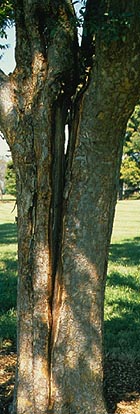Home > Tree structure basics > Structural defects > Split trunks and branches
Split trunks and branches
Trunks split for a variety of reasons. Bark inclusions often cause splits in the trunk. Inclusions result from bark becoming trapped in the union of two trunks or between a branch and the trunk. This represents a weak point in the trunk that can result in cracks and tree failure (see photos).
 The
origin of cracks and splits can also be traced back to a previous
injury. This injury can include root cutting, large branch removal, trunk
wounds, cold damage, flush cuts, topping, and lightning damage. Little can be
done to correct splits in the trunk. Trees with large cracks can be braced
and cabled together to help stabilize them (See: cabling and bracing). This is a high maintenance treatment
requiring regular followup and periodic adjustment. Over watering and overfertilizing
can also kill roots and result in trunk splitting.
The
origin of cracks and splits can also be traced back to a previous
injury. This injury can include root cutting, large branch removal, trunk
wounds, cold damage, flush cuts, topping, and lightning damage. Little can be
done to correct splits in the trunk. Trees with large cracks can be braced
and cabled together to help stabilize them (See: cabling and bracing). This is a high maintenance treatment
requiring regular followup and periodic adjustment. Over watering and overfertilizing
can also kill roots and result in trunk splitting.
Cold damage and trunk disease can cause splits and cracks. Phytophthora fungi following cold injury has been associated with lower trunk damage on Chinese elm trees (lower right).


